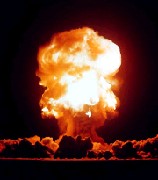|
QuarkJets posted:I'm not sure if you're serious, but I was making a joke. "NIMBY" (not in my back yard) is a common complain for people who don't want a nuclear power plant anywhere near them, not even in the same state This also applies to wind farms, power transmission lines, and pretty much anything that isn't an expensive private school giving their kids a full-ride scholarship.
|
|
|
|

|
| # ? May 10, 2024 05:48 |
|
Groda posted:Still causes more cancer than any coal plant I've worked at... [Citation Needed]
|
|
|
|
CommieGIR posted:[Citation Needed]
|
|
|
|
Pander posted:Skin cancer is pretty prevalent... The curse of nuclear fusion.
|
|
|
|
CommieGIR posted:The curse of nuclear fusion. That's what can unite this thread: trying to get solar called "distributed nuclear fusion reactor-generation stations".
|
|
|
|
Trabisnikof posted:That's what can unite this thread: trying to get solar called "distributed nuclear fusion reactor-generation stations". "The sun is nuclear! Oh my god, you realize what that means, the sun could turn into a bomb!" Yes. And it will. Someday.
|
|
|
|
CommieGIR posted:"The sun is nuclear! Oh my god, you realize what that means, the sun could turn into a bomb!" If it wasn't for the sun we would have no war, no disease or famine. If we ban the sun, we could stop almost all skin cancers, dramatically reduce water consumption worldwide, and only someone who hates America could support the sun!
|
|
|
|
It's almost as bad as DHMO. Did you know DHMO is the primary cause of every major flood in the past two centuries?
|
|
|
|
OwlFancier posted:It's almost as bad as DHMO.
|
|
|
|
GulMadred posted:Typical anti-DHMO propaganda. You don't even need to go back one century to find a deadly non-DHMO flood. Typical pro-DHMO obfuscation, Molasses is 21% DHMO by weight.
|
|
|
|
Trabisnikof posted:Typical pro-DHMO obfuscation, Molasses is 21% DHMO by weight. And likely accounts for the majority of its fluidity, though you could argue that removing all of the DHMO from something and grinding it to a fine enough powder would still create a very viable fluid, and also be rather more terrifying in a flood  I actually had a question, the OP states that wind turbines are among the cheapest and most efficient forms of power generation, is this speaking generally, as in comparison to conventional fossil fuel approaches, or does it mean 'among renewable alternatives' Essentially in the UK we're building quite a number of wind farms, including a rather silly looking offshore one near me, but I believe most of them are built with government funding, or on crown land, rent free, and such. So I was wondering how they actually measure up in terms of efficient energy generation and economic viability, and I can't find the numbers I'm after on google, though that may be not knowing what to type.
|
|
|
|
OwlFancier posted:And likely accounts for the majority of its fluidity, though you could argue that removing all of the DHMO from something and grinding it to a fine enough powder would still create a very viable fluid, and also be rather more terrifying in a flood A single wind turbine is probably cheaper than a coal plant but it also won't give you nearly as much electricity.
|
|
|
|
computer parts posted:A single wind turbine is probably cheaper than a coal plant but it also won't give you nearly as much electricity. Each turbine is rated for 1-2MW depending on location, wind strength, and type. To match the current output of a single coal plant, something like ~600MW, you'd need at least 300 turbines. 300. Individual. Generators. Let's take this back to the US for a second, Greenpeace recently published a photo arguing that China has exceeded US Nuclear production with Wind alone. Its true, they have. China has around 117,000MW worth of Wind. US has 98,000 MW of Nuclear. Except that amount only covers 1/10th of China's power usage, the majority STILL being Coal, and their Coal usage is only growing. So, if we wanted to replace our 98,000MW of nuclear with wind, we'd need....49,000 wind turbines, but that's before you realize that most wind turbine farms only operate at 2/3rd their total capacity, if that.
|
|
|
|
OwlFancier posted:I actually had a question, the OP states that wind turbines are among the cheapest and most efficient forms of power generation, is this speaking generally, as in comparison to conventional fossil fuel approaches, or does it mean 'among renewable alternatives' It is cheapest in comparison to conventional power, but it also comes with a few asterisks. It's cheapest when it's a small amount of wind, but it gets a bit more expensive the larger percentage of your power comes from wind. This is due to needing to build grid improvements to actually harness that power during high winds, otherwise that energy gets wasted, reducing its cost effectiveness. They measure up quite well on the technical and economic points. Generally, wind gets a ton of subsidies because the grid operators mostly like it (out of the renewable options, wind lacks a lot of the others' downsides), their lobby was pretty successful as a result, and of course, because subsidies are necessary to spur fast enough build-out. To the operator, it's always cheaper to try to nurse along an aging coal plant than to make a big capital investment to build something new. The easiest thing to do to find hard statistics is look for someplace that has a lot of wind power (I like Iowa) and then look at government reports and such about it. e: wikipedia has a lot of info for the uk: http://en.wikipedia.org/wiki/Wind_power_in_the_United_Kingdom CommieGIR posted:we'd need....49,000 wind turbines, but that's before you realize that most wind turbine farms only operate at 2/3rd their total capacity, if that. Generally, a wind generator gets an average of about 33% of its nameplate capacity. (This fact is already factored in to what I said earlier about its cost effectiveness, though.) crazypenguin fucked around with this message at 15:32 on Mar 19, 2015 |
|
|
|
OwlFancier posted:Essentially in the UK we're building quite a number of wind farms, including a rather silly looking offshore one near me, but I believe most of them are built with government funding, or on crown land, rent free, and such. So I was wondering how they actually measure up in terms of efficient energy generation and economic viability, and I can't find the numbers I'm after on google, though that may be not knowing what to type. Onshore wind is cheap, only beaten by natural gas. Offshore wind is quite expensive. The DOE and NREL jointly run a database of energy generation cost estimates compiled from a range of different sources. http://en.openei.org/apps/TCDB/
|
|
|
|
Trabisnikof posted:If it wasn't for the sun we would have no war, no disease or famine. If we ban the sun, we could stop almost all skin cancers, dramatically reduce water consumption worldwide, and only someone who hates America could support the sun! Everyone will die in the future. Ban Time.
|
|
|
|
OwlFancier posted:Essentially in the UK we're building quite a number of wind farms, including a rather silly looking offshore one near me, but I believe most of them are built with government funding, or on crown land, rent free, and such. So I was wondering how they actually measure up in terms of efficient energy generation and economic viability, and I can't find the numbers I'm after on google, though that may be not knowing what to type. Wind farm subsidies are great for the developer. For current farms, you get Renewables Obligation Certificates as you generate electricity, which energy suppliers are obliged to buy from you, providing a subsidy of something like £40/MWh generated. Coming along in the near future, we'll have contracts for difference. Essentially, you negotiate a strike price, and you receive the difference between the strike price and the day-ahead price of power as a subsidy. Energy companies are then billed for this subsidy. This means that you have pretty much no price risk on selling your power - it's guaranteed before you start planting turbines.
|
|
|
|
RDevz posted:Wind farm subsidies are great for the developer. For current farms, you get Renewables Obligation Certificates as you generate electricity, which energy suppliers are obliged to buy from you, providing a subsidy of something like £40/MWh generated. Coming along in the near future, we'll have contracts for difference. Essentially, you negotiate a strike price, and you receive the difference between the strike price and the day-ahead price of power as a subsidy. Energy companies are then billed for this subsidy. This means that you have pretty much no price risk on selling your power - it's guaranteed before you start planting turbines. That was sort of what I was wondering about, is wind power actually practical outside of governments throwing money at it. Information seems to point at it being useful if you have a good location for it but possibly not likely to form the backbone of an energy economy. As we have a fair few people who hate wind turbines with the fury of a thousand suns, it's pertinent I think to be able to respond accurately to them.
|
|
|
|
OwlFancier posted:That was sort of what I was wondering about, is wind power actually practical outside of governments throwing money at it. Yeah, as the EIA report I linked in the climate change thread goes over (http://energy.gov/eere/wind/wind-vision), a US grid with 30%+ wind by 2050 is both very doable, requiring marginal increases in investment and with benefits far outweighing the costs. 30% still means we're using other resources, but putting all our eggs in one energy basket hasn't ever worked out before.
|
|
|
|
OwlFancier posted:I believe most of them are built with government funding, or on crown land, rent free, and such. I don't know if this is the case outside of Australia, but here, there literally isn't a single fossil fuel generator asset that wasn't built with either whole or part assistance from the government, which is why the "but SUBSIDIES!" people are so laughable here.
|
|
|
|
OwlFancier posted:That was sort of what I was wondering about, is wind power actually practical outside of governments throwing money at it. Wind power is limited so it can never be the principal energy provider. If anyone is arguing this they are wrong. However, it's very, very cheap in the right places which makes it really dumb to not to use it if you can. I mean if you can put up some turbines in a good spot but don't, and instead burn more coal, you are literally paying money to spray toxins into your environment.
|
|
|
|
Anosmoman posted:Wind power is limited so it can never be the principal energy provider. If anyone is arguing this they are wrong. However, it's very, very cheap in the right places which makes it really dumb to not to use it if you can. I mean if you can put up some turbines in a good spot but don't, and instead burn more coal, you are literally paying money to spray toxins into your environment. Yeah that's more or less probably my standpoint too, they have significant advantages of a small footprint and limited service required, no HGV traffic and such. Also better energy security going forward because once it's up, it's up, the world can melt around it but it'll still work. They don't require you to dig up shitloads of coal and burn it giving everyone COPD forty years down the line, and are remarkably good at not exploding, unlike some other forms of power generation. Downsides would probably be inconsistent generation (though you can work around that, and coal plants have the problem of being too consistent, necessitating the same solutions in order to be efficient) and being a bit weird to set up everywhere, more of a distributed solution than a centralized one.
|
|
|
|
Phanatic posted:Solar eclipse on Friday could cause some big problems in Europe: The eclipse is over, and – nothing happened. There were no blackouts in Germany, not even close. Minimum solar power generation during eclipse: 7 GW; maximum directly after eclipse: 22 GW. There was minimal manual intervention necessary, and only a moderate amount of the purchased reserve power had to be used. So yeah, needless fear mongering once again. Also, it's not like a solar eclipse turns the sun off and on again, like a switch – the transitions took on the order of an hour, each. Source (in German): tagesschau.de.
|
|
|
|
OwlFancier posted:...and are remarkably good at not exploding, unlike some other forms of power generation. I'm being a little cheeky here and obviously it's not on the same scale, but wind turbines also occasionally explode.
|
|
|
|
CombatInformatiker posted:The eclipse is over, and – nothing happened. There were no blackouts in Germany, not even close. Minimum solar power generation during eclipse: 7 GW; maximum directly after eclipse: 22 GW. There was minimal manual intervention necessary, and only a moderate amount of the purchased reserve power had to be used. clearly only because germany does not run a mainly renewable grid yet  (there is a serious argument for
|
|
|
|
blowfish posted:clearly only because germany does not run a mainly renewable grid yet My point was not that solar power as a the majority power source is a viable or even a good idea (it currently isn't, and maybe never will be), rather that if your energy generation mix can deal with a cloudy day, it can deal with an eclipse as least as well – whether it's 1%, 10%, or 100% from solar power.
|
|
|
|
CombatInformatiker posted:My point was not that solar power as a the majority power source is a viable or even a good idea (it currently isn't, and maybe never will be), rather that if your energy generation mix can deal with a cloudy day, it can deal with an eclipse as least as well – whether it's 1%, 10%, or 100% from solar power. The fact that the grid operators were able to reduce the risk from the eclipse to near that of an average day shows how much that has already done to create a more responsive grid. This was a stress test that Europe passed and that proves the viability of current levels of renewables penetration in the European grid.
|
|
|
Trabisnikof posted:Yeah, as the EIA report I linked in the climate change thread goes over (http://energy.gov/eere/wind/wind-vision), a US grid with 30%+ wind by 2050 is both very doable, requiring marginal increases in investment and with benefits far outweighing the costs. 30% still means we're using other resources, but putting all our eggs in one energy basket hasn't ever worked out before. I've skimmed the report, and I still call bullshit. It mentions several times that its findings rely on energy storage, but that's just not feasible. The only plausible way to store adequate amounts of power in the grid with existing technology is by having a fleet of electric cars plugged in and force them to act as grid storage (basically the state owns your battery and can use it how they like). Like a hundred million or so. And that would indeed be an amazingly good thing. But as of now, doing something as incredible as electrifying and nationalizing half the cars in the US is a pipe dream in itself.
|
|
|
|
|
ANIME AKBAR posted:I've skimmed the report, and I still call bullshit. It mentions several times that its findings rely on energy storage, but that's just not feasible. The only plausible way to store adequate amounts of power in the grid with existing technology is by having a fleet of electric cars plugged in and force them to act as grid storage (basically the state owns your battery and can use it how they like). Like a hundred million or so. And that would indeed be an amazingly good thing. But as of now, doing something as incredible as electrifying and nationalizing half the cars in the US is a pipe dream in itself. The EIA actually knows what they are doing and the model they are using is particularly adjusted to the problems of renewables (http://www.nrel.gov/analysis/reeds/description.html). Also storage is an incredibly small part of the generation scenario:  Storage is the hard to see sliver on top of wind in the installed capacity graph. Besides our current experience with wind shows us that we don't need to add large amounts of storage (or significantly increase generation reserves) to deploy wind at large percentages: quote:In regions with wind power contributions up to 20% of annual electrical demand in 2013, electric power systems operated reliably without added storage and with little or no increase in generation reserves [7]. Wind has also been proven to increase system reliability during some severe weather events. For example, in February 2011, cold weather disabled 152 power plants in Texas, mostly coal and natural gas. Wind generation produced approximately 3,500 MW of output during this event, helping to avoid outages [135]. Experience with wind generation confirms that opportunities exist to increase grid operating effi- ciency and reduce costs by increasing flexibility.55
|
|
|
|
Trabisnikof posted:The EIA actually knows what they are doing and the model they are using is particularly adjusted to the problems of renewables (http://www.nrel.gov/analysis/reeds/description.html). Also storage is an incredibly small part of the generation scenario: Why does this plan involve eliminating all nuclear energy, but only eliminating like 60% of coal? Why does it include massively increasing natural gas??? What the gently caress is with this plan?
|
|
|
|
Nintendo Kid posted:Why does this plan involve eliminating all nuclear energy, but only eliminating like 60% of coal? Why does it include massively increasing natural gas??? Its a look at the costs and benefits of a 30% wind grid, assuming business as usual for non-wind things. Thus the decline of nuclear energy as the reactors go out of license and the rise of natural gas combined cycle to replace those nukes and aging coal plants.
|
|
|
|
Nintendo Kid posted:Why does this plan involve eliminating all nuclear energy, but only eliminating like 60% of coal? Why does it include massively increasing natural gas??? An unfortunately large number of environmentalist projects are infected with the usual idiocy that nuclear is just as bad coal. The last "roadmap plan" I saw (I forget the source, earlier in this thread certainly) showed nuclear being replaced primarily by biomass to the tune of about 40% of total generation. This one shows appears to show nuclear getting replaced primarily by natural gas. I'm as confused as you are why anyone would think this is a good idea. ANIME AKBAR posted:The only plausible way to store adequate amounts of power in the grid with existing technology is by having a fleet of electric cars plugged in and force them to act as grid storage (basically the state owns your battery and can use it how they like). Like a hundred million or so. And that would indeed be an amazingly good thing. But as of now, doing something as incredible as electrifying and nationalizing half the cars in the US is a pipe dream in itself. One of the things I feel like I repeat a lot (because it surprised the hell out of me, and it's a mistake I see almost everyone else making too) is that the storage needed due to the variability of wind is NOT necessary to make up for a shortfall of power generation. It's necessary to make use of power generated when winds are HIGH. There's EXCESS power. Yes. We can use electric cars to do this, just fine, no problem. Offer people a slight discount on power if they use "eco-charge" on their cars. Charge at 60% normal rate, unless the grid is yelling "hey everyone I've got power to spare! gimmee all you got!" in which case, hit 100%. There's no discharging of those batteries back into the grid. Not necessary.
|
|
|
|
Trabisnikof posted:Its a look at the costs and benefits of a 30% wind grid, assuming business as usual for non-wind things. Thus the decline of nuclear energy as the reactors go out of license and the rise of natural gas combined cycle to replace those nukes and aging coal plants. So it's already bullshit from the start, as it doesn't depict Georgia's two new nuclear reactors scheduled to go online int he late 2010s and early 2020s among other things. So it's all useless.
|
|
|
|
Nintendo Kid posted:So it's already bullshit from the start, as it doesn't depict Georgia's two new nuclear reactors scheduled to go online int he late 2010s and early 2020s among other things. So it's all useless. Not sure how the replacement of nuclear power is related to the wind generation component of the report.
|
|
|
|
OwlFancier posted:Not sure how the replacement of nuclear power is related to the wind generation component of the report. Because the report does not deal with a realistic future: it's already ignoring power projects that are underway and have been underway for 5 years. Would you think a report on future office space in NYC that neglects to consider 9/11 was useful?
|
|
|
|
OwlFancier posted:Not sure how the replacement of nuclear power is related to the wind generation component of the report.
|
|
|
|
Nintendo Kid posted:Because the report does not deal with a realistic future: it's already ignoring power projects that are underway and have been underway for 5 years. Would you think a report on future office space in NYC that neglects to consider 9/11 was useful? Yes but I don't see why that is relevant to the parts detailing the viability of large scale wind deployment? Does it greatly matter whether the rest of the generation is supplied by nuclear or gas power? You don't have to take the entire report as written, it would seem quite possible to look at the information provided about wind power alone and possibly incorporate that into a more accurate assessment which includes the renewal of nuclear energy. Essentially I don't get why "there is an error so all the information is wrong" is valid reasoning.
|
|
|
|
Wind Vision anticipates nuclear and coal retirements in part due to low natural gas prices. There are currently 5 reactors under construction in the U.S., and four of them are plagued by "dismal cost overruns and multi-year delays," according to the Wall Street Journal. That hardly sounds like the start of a promising growth trajectory. It's been proven by experience that grids can handle large percentages of wind and solar, you don't need nuclear (or storage for that matter) for a low-carbon energy mix. As many of you said, Wind Vision is a roadmap. The point of the report is to show people that the U.S. can achieve this growth in wind power.
|
|
|
|
Cyclopean Horror posted:Wind Vision anticipates nuclear and coal retirements in part due to low natural gas prices. There are currently 5 reactors under construction in the U.S., and four of them are plagued by "dismal cost overruns and multi-year delays," according to the Wall Street Journal. That hardly sounds like the start of a promising growth trajectory. Wind and Solar are not going to sustain the grid by themselves, and Natural Gas is just the coal/gas industry trying to stay relevant. Unless we make big leaps in energy storage or cars being plugged into the grid becomes the norm, Wind and Solar are very good supplements, but even Germany is still mostly dependent upon coal and natural gas.
|
|
|
|

|
| # ? May 10, 2024 05:48 |
|
CommieGIR posted:Wind and Solar are not going to sustain the grid by themselves, and Natural Gas is just the coal/gas industry trying to stay relevant.
|
|
|




















 I CANNOT EJACULATE WITHOUT SEEING NATIVE AMERICANS BRUTALISED!
I CANNOT EJACULATE WITHOUT SEEING NATIVE AMERICANS BRUTALISED!

